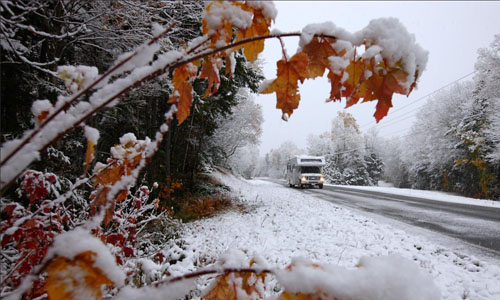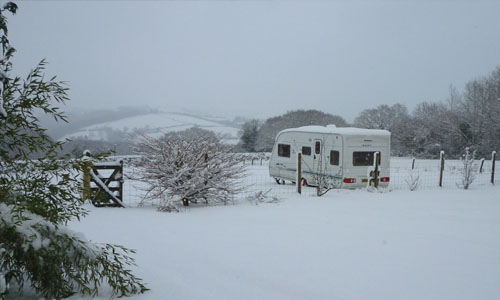Spending the Cold Months in an Adventure Rig
Author

Chris shares his passion for cycling, hiking, skiing, and climbing from Buxton, in the Peak District. As a blogger for Outdoor Look, Chris shares outdoor tips and indoor tricks to help you get the most out of your time spent outside. When he's not out adventuring he's making videos or trying to keep up with his 4-year-old son.
 There is no denying the fact that travelling through the beaches and the countryside in an adventure rig is quite fun. These often-customised vehicles are the perfect way to travel around and have the ability to easily set up a basecamp wherever you choose. But surviving near-zero temperatures is a whole other ball game, especially during the night. Adventure rigs are not often designed with cold weather habitation in mind. The trick is to prepare yourself and your rig to tackle the extreme temperatures comfortably.
There is no denying the fact that travelling through the beaches and the countryside in an adventure rig is quite fun. These often-customised vehicles are the perfect way to travel around and have the ability to easily set up a basecamp wherever you choose. But surviving near-zero temperatures is a whole other ball game, especially during the night. Adventure rigs are not often designed with cold weather habitation in mind. The trick is to prepare yourself and your rig to tackle the extreme temperatures comfortably.
1. Physical Activity
You’d think that any person on a jog in winters is mad, but actually they are stretching their bodies, working their muscles, increasing the blood flow through their veins and heating their bodies up. Warm blankets and sleeping bags might feel cosy, but leaving them for some physical activity will make you feel revitalised.
Some proper planning and implementation will easily get you through the winter. Travel through different places to find the beauty of nature. Head south if you feel like you need more sunlight. Make new friends along the way, share your experiences and find new places to travel.
2. Heat Source
Some people choose to brave the winters with additional layers of clothing and insulation, but many are also of the opinion that a little heat boost is always better. Wood burning stoves are quite convenient when you are a camper but they can only be used when the vehicle is parked. Electric heaters are also available in the market; my advice is to pick the one with the automatic timer-off feature and low electricity consumption. Portable propane heaters can also be used as they are easy to carry and can be used while on-the-go.
3. Proper Insulation
Instead of covering every nook and cranny of your vehicle with insulation foam, a proper inspection for air passages through windows, doors, floors and walls will tell you what should be sealed first. Small interior holes can be covered using small pieces of tape, and sealant can be used to prevent leaks and mold in the roof.
Choose the level and type of insulation according to your comfort level. You can install the insulation while remembering that this insulation will also provide insulation against the summer heat. A multi-layer insulation with radiant barrier on the outside and Styrofoam on the inside - that's the ticket. Wood paneling can be used to hide the Styrofoam.
 4. Solar Energy
4. Solar Energy
Natural heat energy from the sun is crucial for us, especially in winters when it becomes a rarity. As the days in winter are shorter, more passive solar heat can be collected if the windows are facing south. Removing the insulation from the windows is a good idea in such case. And if you decide to spend your day indoors, spend it sitting near the windows.
5. Layered Dressing
After the insulation of the vehicle you have to properly insulate your body too. And like insulating your rig, effective body insulation can be easily achieved by multiple layers of clothes. Starting from a base layer of synthetic fiber or wool, add a fleece or wool layer over it and if you still do not feel comfortable and warm, add another layer according to your suiting. A woolen beanie and socks also help in preventing major heat loss. Make arrangements for a 0-degree sleeping bag for the chilly nights.
6. Switch to Indoor Cooking
Cooking your favorite meals over flame is the best way to warm your body and then treat it with delicious food. Often, propane fueled camp stoves and wood burning stoves are the top choice, but some people also use induction cookers. Cooking indoors will not only warm you, but it will also increase the temperature inside the van. And as you have already insulated the vehicle properly, the fall in temperature will be slow.
Author

Chris shares his passion for cycling, hiking, skiing, and climbing from Buxton, in the Peak District. As a blogger for Outdoor Look, Chris shares outdoor tips and indoor tricks to help you get the most out of your time spent outside. When he's not out adventuring he's making videos or trying to keep up with his 4-year-old son.
- Speed Up Your Post-Hike Recovery with These 6 Essential Tips
- Cycling through Tranquil Roads and Coastal Views on the Isle of Wight
- The Essential Guide to Hiking Safety: 5 Tips Every Hiker Should Know
- Run Smart, Run Strong: Your Guide to Injury-Free Running
- Embrace Biking: Essential Tips for Beginners
Categories
- Sport (28)
- Product Reviews (3)
- Team Outdoor Look (7)
- Mike Wild (2)
- Mike Payton (2)
- Suse Hammond-Pears (3)
- Snowboarding (12)
- Latest Offers (105)
- Shop Talk (1)
- Competitions (7)
- Walking (413)
- Lifestyle Fashion (8)
- Travel (86)
- Kit Guides (176)
- Workwear Clothing (6)
- Safety Workwear (4)
- Health/Fitness (289)
- Skiing (91)
- Great Outdoors (1316)
- Cycling (92)
- January 2025
- December 2024
- November 2024
- October 2024
- September 2024
- August 2024
- July 2024
- June 2024
- May 2024
- April 2024
- March 2024
- February 2024
- January 2024
- December 2023
- November 2023
- October 2023
- September 2023
- August 2023
- July 2023
- June 2023
- May 2023
- April 2023
- March 2023
- February 2023
- January 2023
- December 2022
- November 2022
- October 2022
- September 2022
- August 2022
- July 2022
- June 2022
- May 2022
- April 2022
- March 2022
- February 2022
- January 2022
- December 2021
- November 2021
- October 2021
- September 2021
- August 2021
- July 2021
- June 2021
- May 2021
- April 2021
- March 2021
- February 2021
- January 2021
- December 2020
- November 2020
- October 2020
- September 2020
- August 2020
- July 2020
- June 2020
- May 2020
- April 2020
- March 2020
- February 2020
- January 2020
- December 2019
- November 2019
- October 2019
- September 2019
- August 2019
- July 2019
- June 2019
- May 2019
- April 2019
- March 2019
- February 2019
- January 2019
- December 2018
- November 2018
- October 2018
- September 2018
- August 2018
- July 2018
- June 2018
- May 2018
- April 2018
- March 2018
- February 2018
- January 2018
- December 2017
- November 2017
- October 2017
- September 2017
- August 2017
- July 2017
- June 2017
- May 2017
- April 2017
- March 2017
- February 2017
- January 2017
- December 2016
- November 2016
- October 2016
- September 2016
- August 2016
- July 2016
- June 2016
- May 2016
- April 2016
- March 2016
- February 2016
- January 2016
- December 2015
- November 2015
- October 2015
- September 2015
- August 2015
- July 2015
- June 2015
- May 2015
- April 2015
- March 2015
- February 2015
- January 2015
- December 2014
- November 2014
- October 2014
- September 2014
- August 2014
- July 2014
- June 2014
- May 2014
- April 2014
- March 2014
- February 2014
- January 2014
- December 2013
- November 2013
- October 2013
- September 2013
- August 2013
- July 2013
- June 2013
- May 2013
- April 2013
- March 2013
- February 2013
- January 2013
- December 2012
- November 2012
- October 2012
- September 2012
- August 2012
- July 2012
- June 2012
- May 2012
- April 2012
- March 2012
- February 2012
- January 2012
- December 2011
- November 2011
- October 2011
- September 2011
- August 2011
- May 2010
- April 2010
- March 2010
- February 2010
- January 2010
- November 2009
- October 2009
- September 2009
Submit a Comment